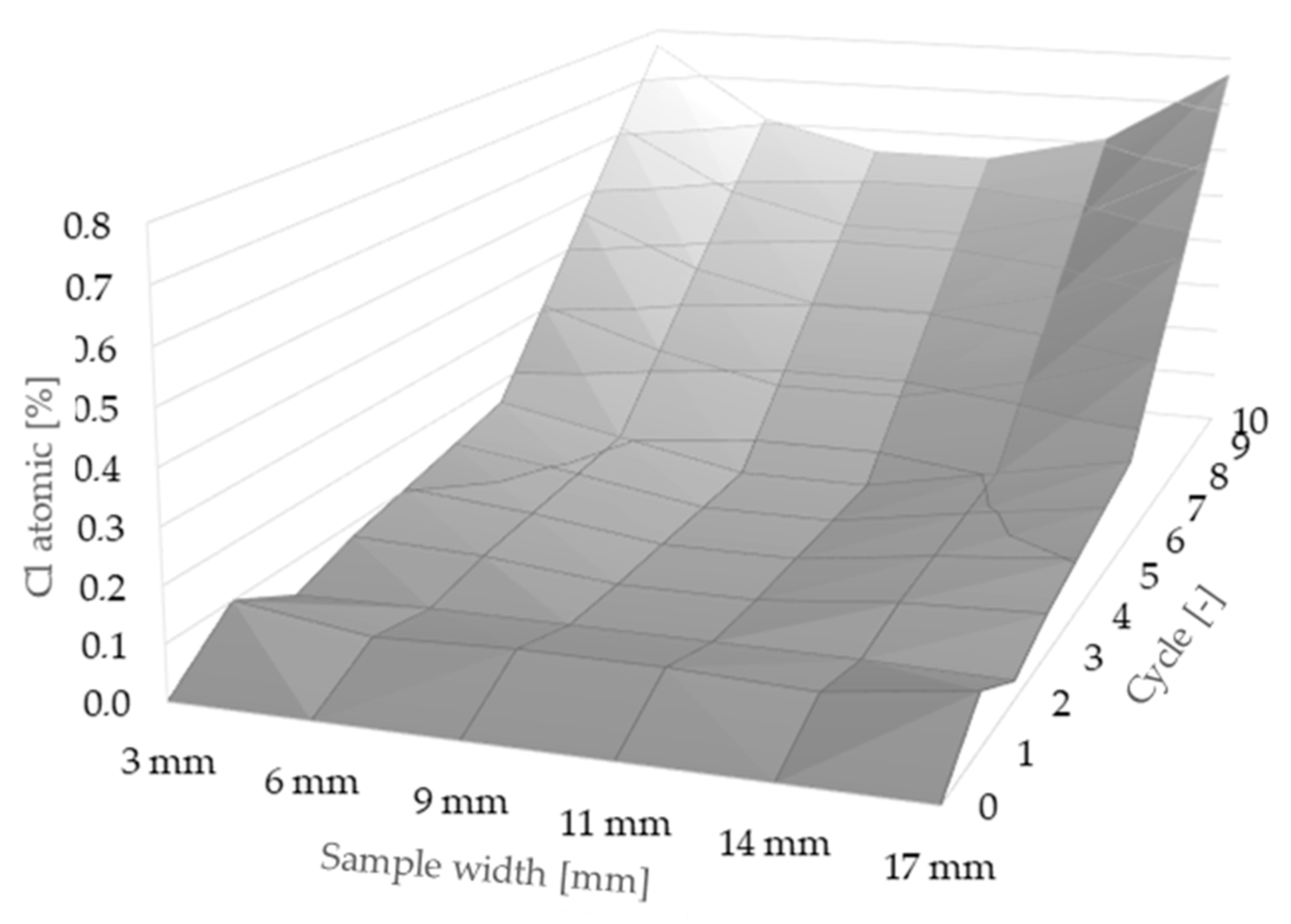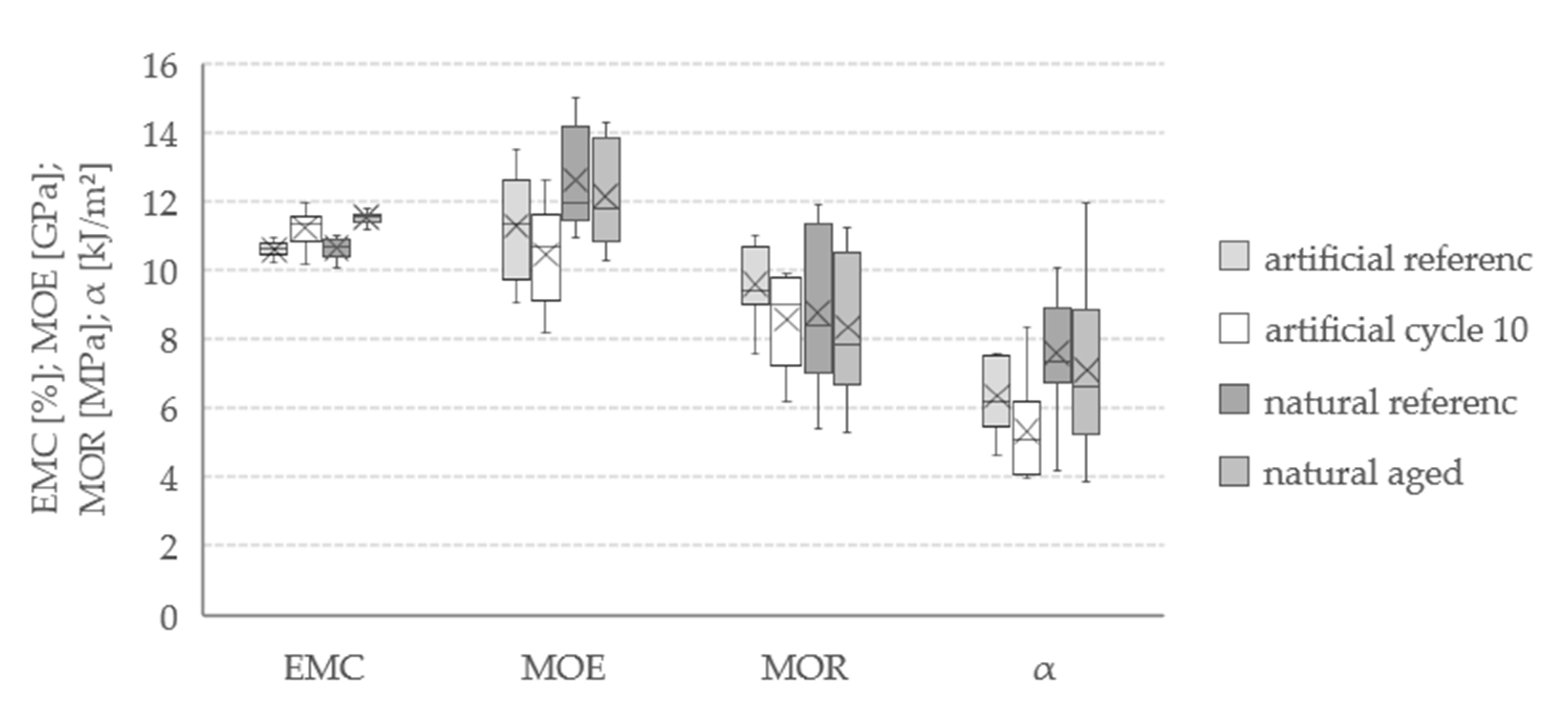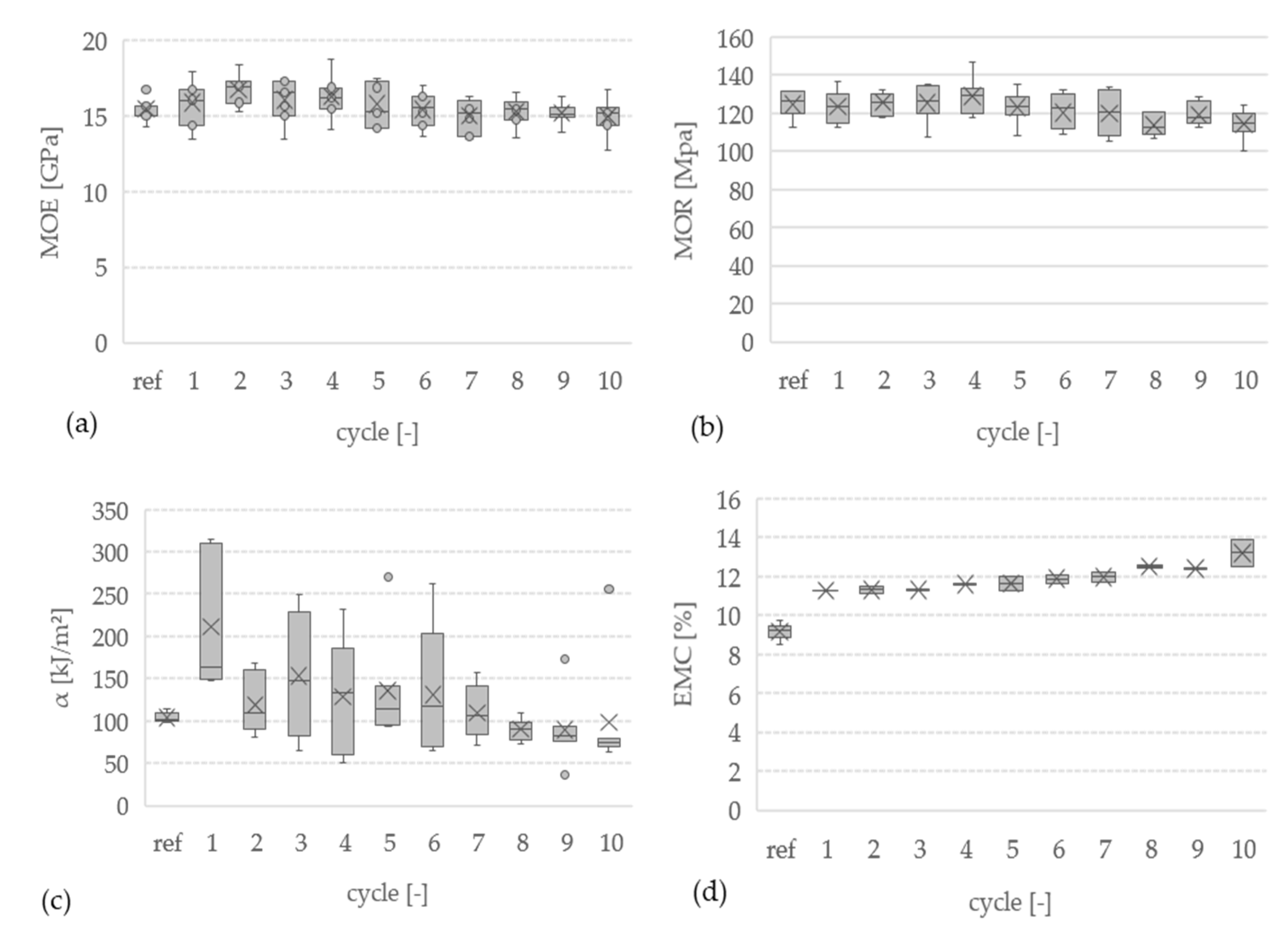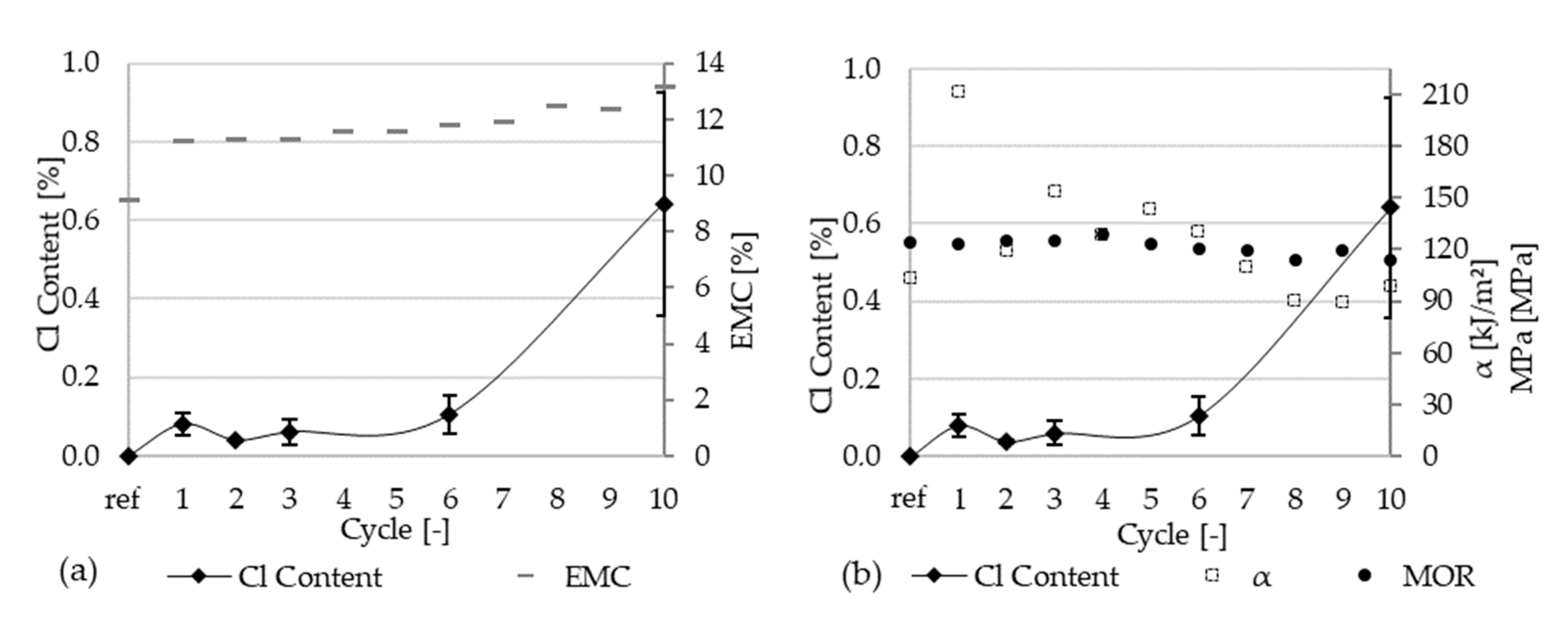Durability of Wood Exposed to Alternating Climate Test and Natural Weathering
Abstract
1. Introduction
2. Materials and Methods
2.1. Natural Weathering
2.2. Artificial Weathering
2.3. Mechanical Properties
2.4. Microscopic Inspection
2.5. Statistics
3. Results and Discussion
3.1. Sample Properties
3.2. Weathering Effects on Oak Wood
3.3. Weathering Effects on Birch Wood
3.4. Elementary Analysis
4. Conclusions
Author Contributions
Funding
Acknowledgments
Conflicts of Interest
References
- Friedrich, H.E. Leichtbau in Der Fahrzeugtechnik; Springer: Stuttgart, Germany, 2017; ISBN 3658122951. [Google Scholar]
- Baumann, G.; Stadlmann, A.; Kurzböck, C.; Feist, F. Crashsichere Holzverbundwerkstoffe in Leichtbaukarosserien der Zukunft. ATZ—Automob. Zeitschrift 2019, 121, 54–59. [Google Scholar] [CrossRef]
- Mair, C.; Zimek, M.; Stern, T.; Baumgartner, R.J. Sustainability performance of wood based materials: A systemic assessment of lightweight materials for the mobility sector. In Proceedings of the 24th Annual ISDRS Conference, Messina, Italy, 13–15 June 2018. [Google Scholar]
- Kohl, D.; Link, P.; Böhm, S. Wood as a Technical Material for Structural Vehicle Components. Procedia CIRP 2016, 40, 557–561. [Google Scholar] [CrossRef]
- Leitgeb, W.; Kerschbichler, S.; Jost, T.; Mayrhofer, P.; Wagner, W.; Müller, U. Holz im strukturellen Fahrzeugbau. In Proceedings of the IHD, Konferenzproceedings—2. Interdisziplinäres Fahrzeugkolloquium, Dresden, Germany, 15–16 January 2016; pp. 1–118. [Google Scholar]
- Müller, U.; Jost, T.; Kurzböck, C.; Stadlmann, A.; Wagner, W.; Kirschbichler, S.; Baumann, G.; Feist, F. Crash simulation of wood and composite wood for future automotive engineering. Wood Mater. Sci. Eng. 2019. [Google Scholar] [CrossRef]
- Jost, T.; Müller, U.; Feist, F. Wood Composites for Future Automotive Engineering?–Basic Requirement: Crash Simulation of Wood-Based Components Holzverbundwerkstoffe im Automobilbau der Zukunft?–Grundvoraussetzung: Crashsimulation von Holzkomponenten. Konstruktion 2018, 10, 74–82. [Google Scholar]
- EC European Commission. A Sustainable Bioeconomy for Europe: Strengthening the Connection between Economy, Society; COM(2018) 673 final; EC European Commission: Brussel, Belgium, 2018. [Google Scholar]
- Asada, R.; Cardellini, G.; Mair-Bauernfeind, C.; Wenger, J.; Haas, V.; Holzer, D.; Stern, T. Effective bioeconomy? A MRIO-based socioeconomic and environmental impact assessment of generic sectoral innovations. Technol. Forecast. Soc. Change 2020, 153, 119946. [Google Scholar] [CrossRef]
- Feist, F.; Baumann, G.; Müller, U.; Stadlmann, A.; Kumpenza, C. Aufprallschutz, insbesondere Seitenaufprallschutz für eine Fahrzeugtür 2020. Available online: http://see-ip.patentamt.at/NPatentSuche/SearchResult (accessed on 22 July 2020).
- Müller, U.; Kirschbichler, S.; Leitgeb, W.; Jost, T. The Road from Creating a Material Model to a Structural Component of Wood for Automotive Applications. In Proceedings of the TU Verlag; Füssl, J., Bader, T.K., Eberhardsteiner, J., Eds.; The CompWood 2017 Programme & Book of Abstracts; TU Verlag: Vienna, Italy, 2017. [Google Scholar]
- Li, Z.; He, M. Finite Element Modeling and Parametric Analysis of Timber-Steel Hybrid Structures. Struct. Des. Tall Spec. Build. 2014, 23, 1045–1063. [Google Scholar] [CrossRef]
- Erler, K. Holz im Außenbereich: Anwendungen, Holzschutz, Schadensvermeidung; Springer: Berlin/Heidelberg, Germany, 2013; ISBN 3034881118. [Google Scholar]
- Flanagan, J.; Schütze, P.; Dunne, C.; Twomey, B.; Stanton, K.T. Use of a blast coating process to promote adhesion between aluminium surfaces for the automotive industry. J. Adhes. 2020, 96, 580–601. [Google Scholar] [CrossRef]
- Luckeneder, G.; Autengruber, R.; Stellnberger, K.-H.; Kurz, J.F.T. Corrosion Protection of Galvanized Press-Hardening Steel: Main Influencing Factors and Mechanisms. In Proceedings of the Galvatech 2015 Conference Proceedings, Toronto, ON, Canada, 31 May–4 June 2015; pp. 868–875. [Google Scholar]
- Vargel, C. Corrosion of Aluminium; Elsevier: Amsterdam, The Netherlands, 2004; ISBN 0080444954. [Google Scholar]
- Makar, G.L.; Kruger, J. Corrosion of magnesium. Int. Mater. Rev. 1993, 38, 138–153. [Google Scholar] [CrossRef]
- Scheiding, W.; Grabes, P.; Haustein, T.; Haustein, V.; Nieke, N.; Urban, H.; Weiß, B. Holzschutz: Holzkunde-Pilze und Insekten-Konstruktive und chemische Maßnahmen-Technische Regeln-Praxiswissen; Carl Hanser Verlag GmbH Co KG: Leipzig, Germany, 2016; ISBN 978-3-446-44777-6. [Google Scholar]
- Müller, U.; Müller, H.; Teischinger, A. Durability of wood adhesives in 50 year old aircraft and glider constructions. Wood Res. 2004, 49, 25–34. [Google Scholar]
- ÖNORM EN 350 Dauerhaftigkeit von Holz und Holzprodukten―Prüfung und Klassifikation der Dauerhaftigkeit von Holz und Holzprodukten Gegen Biologischen Angriff; Austrian Standards: Vienna, Austria, 2017.
- Müller, U.; Feist, F.; Jost, T. Wood composites in the automotive industry of the future? Assumed crash tests and simulation of wood materials. Holztechnologie 2019, 5–15. [Google Scholar] [CrossRef]
- Kollmann, F. Technologie des Holzes und der Holzwerkstoffe, 2nd ed.; Springer: Berlin/Heidelberg, Germany, 1951. [Google Scholar]
- Phleger, C.F. Effect of salinity on growth of a salt marsh grass. Ecology 1971, 52, 908–911. [Google Scholar] [CrossRef]
- Parida, A.K.; Jha, B. Salt tolerance mechanisms in mangroves: A review. Trees Struct. Funct. 2010, 24, 199–217. [Google Scholar] [CrossRef]
- Tintner, J.; Smidt, E.; Tieben, J.; Reschreiter, H.; Kowarik, K.; Grabner, M. Aging of wood under long-term storage in a salt environment. Wood Sci. Technol. 2016, 50, 953–961. [Google Scholar] [CrossRef][Green Version]
- 11997-1, D.E.I. Paints and Varnishes—Determination of Resistance to Cyclic Corrosion Conditions—Part 1: Wet (Salt Fog)/Dry/Humid (ISO 11997-1:2017); EN ISO 11997-1:2017; ISO: Berlin, Germany, 2017. (In German) [Google Scholar]
- DIN 52 186 Prüfung von Holz—Biegeversuch; Wien, Austria. Available online: https://literatur.thuenen.de/digbib_extern/dk040246.pdf (accessed on 30 August 2020).
- DIN 52 189 Prüfung von Holz—Schlagbiegeversuch; Bestimmung der Bruchschlagarbeit; Wien, Austria. Available online: http://www.woodcar.eu/wa_files/muller%20feist%20jost_dresden.pdf (accessed on 30 August 2020).
- ISO 554 Normalklimate für die Konditionierung und/oder Prüfung: Anforderungen; ISO: Geneva, Switzerland, 1976.
- DIN 52 182 Prüfung von Holz—Bestimmung der Rohdichte; 1976. Available online: https://literatur.thuenen.de/digbib_extern/dk040246.pdf (accessed on 30 August 2020).
- Niemz, P.; Sonderegger, W. Holzphysik: Physik des Holzes und der Holzwerkstoffe; Carl Hanser Verlag GmbH Co KG: Zürich, France, 2017; ISBN 3446445463. [Google Scholar]
- Kránitz, K.; Sonderegger, W.; Bues, C.T.; Niemz, P. Effects of aging on wood: A literature review. Wood Sci. Technol. 2016, 50, 7–22. [Google Scholar] [CrossRef]
- Sonderegger, W.; Kránitz, K.; Bues, C.T.; Niemz, P. Aging effects on physical and mechanical properties of spruce, fir and oak wood. J. Cult. Herit. 2015, 16, 883–889. [Google Scholar] [CrossRef]
- Obataya, E. Effects of natural and artificial ageing on the physical and acoustic properties of wood in musical instruments. J. Cult. Herit. 2017, 27, S63–S69. [Google Scholar] [CrossRef]
- Erhardt, D.; Mecklenburg, M.F.; Tumosa, C.S.; Olstad, T.M. New vs old wood: Differences and similarities in physical, mechanical, and chemical properties. ICOM Comm. Conserv. Prepr. 1996, 2, 903–910. [Google Scholar]
- Sonderegger, W.; Niemz, P. The influence of compression failure on the bending, impact bending and tensile strength of spruce wood and the evaluation of non-destructive methods for early detection. Holz als Rohund Werkst. 2004, 62, 335–342. [Google Scholar] [CrossRef][Green Version]
- Lang, A. Charakterisierung des Altholzaufkommens in Deutschland: Rechtliche Rahmenbedingungen, Mengenpotenzial, Materialkennwerte; Wiedebusch: Hamburg, Germany, 2004. [Google Scholar]
- Sell, J. Eigenschaften und Kenngrößen von Holzarten; Baufachverlag AG: Zürich, Framce, 1989. [Google Scholar]
- Wagenführ, R. Holzatlas 6; VEB Fachbuchverlag: Leipzig, Germany, 2006; ISBN 978-3-446-40649-0. [Google Scholar]
- Wilson, T.R.C. Strength-Moisture Relations for Wood; US Dept. of Agriculture: Washington, DC, USA, 1932.
- Willianzs, R.S.; Feist, W.C. Wood Modified By Inorganic Salts: Mechanism Repellency and Iiimensional Stability of Wood Modifieid with Chromium (111) Nitrate Versus Chromic Acid. Wood Fiber Sci. 1985, 17, 184–198. [Google Scholar]
- Rodrıguez, J.J.S.; Hernandez, F.J.S.; Gonzalez, J.E.G. The effect of environmental and meteorological variables on atmospheric corrosion of carbon steel, copper, zinc and aluminium in a limited geographic zone with different types of environment. Corros. Sci. 2003, 45, 799–815. [Google Scholar] [CrossRef]
- Song, G.; Johannesson, B.; Hapugoda, S.; StJohn, D. Galvanic corrosion of magnesium alloy AZ91D in contact with an aluminium alloy, steel and zinc. Corros. Sci. 2004, 46, 955–977. [Google Scholar] [CrossRef]
- Apostolopoulos, C.A. The influence of corrosion and cross-section diameter on the mechanical properties of b500 c steel. J. Mater. Eng. Perform. 2009, 18, 190–195. [Google Scholar] [CrossRef]
- Fengel, D.; Wegener, G. Wood: Chemistry, Ultrastructure, Reactions; Walter de Gruyter: Berlin, Germany; New York, NY, USA, 1989; ISBN 3-11-012059-3. [Google Scholar]
- Oltean, L.; Teischinger, A.; Hansmann, C. Influence of temperature on cracking and mechanical properties of wood during wood drying—A review. BioResources 2007, 2, 789–811. [Google Scholar] [CrossRef]





| Wind Speed (km/h) | Global Radiation (MJ/m2) | Temperature (°C) | Relative Humidity (%) | Precipitation (L/m2) | |
|---|---|---|---|---|---|
| Sum | - | 58,544 | - | - | 9935 |
| Mean value | 8 | 11 | 11 | 75 | 2 |
| max. | 120 | 32 | 37 | 100 | 79 |
| min. | 0 | 0 | −19 | 5 | 0 |
| Stage | Time (h) | Temperature (°C) | Condition | Comment |
|---|---|---|---|---|
| 1 | 24 | 35 ± 2 | Salt spray | |
| 2 | 8 | 40 ± 2 | 100% rel. humidity | Water condenses on the sample |
| 3 | 16 | 23 ± 2 | (50 ± 20)% rel. humidity | - |
| 4 | 8 | 40 ± 2 | 100% rel. humidity | Water condenses on the sample |
| 5 | 16 | 23 ± 2 | (50 ± 20)% rel. humidity | - |
| 6 | 8 | 40 ± 2 | 100% rel. humidity | Water condenses on the sample |
| 7 | 16 | 23 ± 2 | (50 ± 20)% rel. humidity | - |
| 8 | 8 | 40 ± 2 | 100% rel. humidity | Water condenses on the sample |
| 9 | 16 | 23 ± 2 | (50 ± 20)% rel. humidity | - |
| 10 | 48 | 23 ± 2 | (50 ± 20)% rel. humidity | |
| 11 | back to stage 1 | Total duration of a cycle from stage 1 to stage 10 of 7 days | ||
| Statistical Indicator | Birch Reference EMC (%) | Birch Altered EMC (%) | Oak Reference EMC (%) | Oak Altered EMC (%) |
|---|---|---|---|---|
| n | 8 | 8 | 8 | 8 |
| mean | 10.35 | 11.81 | 11.36 | 11.97 |
| SD | 0.63 | 0.18 | 0.58 | 0.14 |
| min. | 9.70 | 11.44 | 10.32 | 11.82 |
| max. | 11.33 | 12.06 | 11.84 | 12.20 |
© 2020 by the authors. Licensee MDPI, Basel, Switzerland. This article is an open access article distributed under the terms and conditions of the Creative Commons Attribution (CC BY) license (http://creativecommons.org/licenses/by/4.0/).
Share and Cite
Stadlmann, A.; Pramreiter, M.; Stingl, R.; Kurzböck, C.; Jost, T.; Müller, U. Durability of Wood Exposed to Alternating Climate Test and Natural Weathering. Forests 2020, 11, 953. https://doi.org/10.3390/f11090953
Stadlmann A, Pramreiter M, Stingl R, Kurzböck C, Jost T, Müller U. Durability of Wood Exposed to Alternating Climate Test and Natural Weathering. Forests. 2020; 11(9):953. https://doi.org/10.3390/f11090953
Chicago/Turabian StyleStadlmann, Alexander, Maximilian Pramreiter, Robert Stingl, Christian Kurzböck, Thomas Jost, and Ulrich Müller. 2020. "Durability of Wood Exposed to Alternating Climate Test and Natural Weathering" Forests 11, no. 9: 953. https://doi.org/10.3390/f11090953
APA StyleStadlmann, A., Pramreiter, M., Stingl, R., Kurzböck, C., Jost, T., & Müller, U. (2020). Durability of Wood Exposed to Alternating Climate Test and Natural Weathering. Forests, 11(9), 953. https://doi.org/10.3390/f11090953






